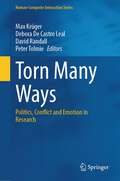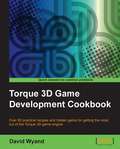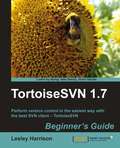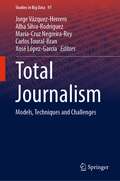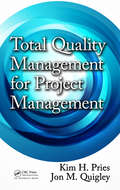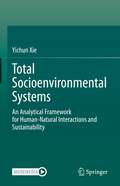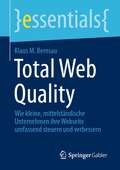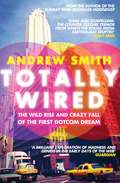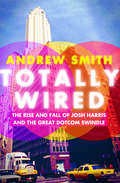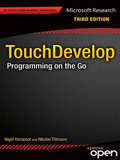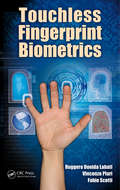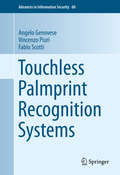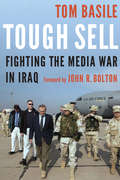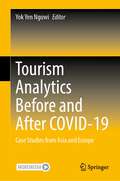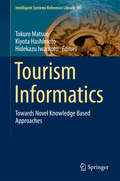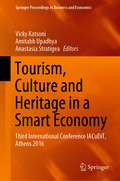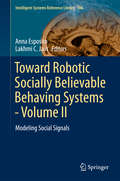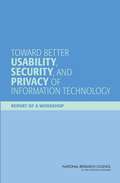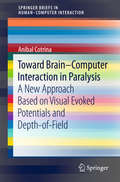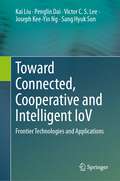- Table View
- List View
Tor: From the Dark Web to the Future of Privacy
by Ben CollierA biography of Tor—a cultural and technological history of power, privacy, and global politics at the internet's core.Tor, one of the most important and misunderstood technologies of the digital age, is best known as the infrastructure underpinning the so-called Dark Web. But the real &“dark web,&” when it comes to Tor, is the hidden history brought to light in this book: where this complex and contested infrastructure came from, why it exists, and how it connects with global power in intricate and intimate ways. In Tor: From the Dark Web to the Future of Privacy, Ben Collier has written, in essence, a biography of Tor—a cultural and technological history of power, privacy, politics, and empire in the deepest reaches of the internet.The story of Tor begins in the 1990s with its creation by the US Navy&’s Naval Research Lab, from a convergence of different cultural worlds. Drawing on in-depth interviews with designers, developers, activists, and users, along with twenty years of mailing lists, design documents, reporting, and legal papers, Collier traces Tor&’s evolution from those early days to its current operation on the frontlines of global digital power—including the strange collaboration between US military scientists and a group of freewheeling hackers called the Cypherpunks. As Collier charts the rise and fall of three different cultures in Tor&’s diverse community—the engineers, the maintainers, and the activists, each with a distinct understanding of and vision for Tor—he reckons with Tor&’s complicated, changing relationship with contemporary US empire. Ultimately, the book reveals how different groups of users have repurposed Tor and built new technologies and worlds of their own around it, with profound implications for the future of the Internet.
Torn Many Ways: Politics, Conflict and Emotion in Research (Human–Computer Interaction Series)
by David Randall Peter Tolmie Max Krüger Debora De Castro LealThis edited collection brings together a range of experiences from the field, largely in the context of CSCW and HCI. It focuses specifically on the experiences of people who have worked in difficult, tense, delicate and sometimes conflictual and dangerous settings. The tensions faced by researchers and, more importantly, how they manage to deal with them are often under-remarked. Unlike the bulk of published ethnographic work, the chapters in this book deal more explicitly with the various practical problems that researchers with varying degrees of experience face. Our aim in this book is to give a voice to researchers who have sometimes contended with unexpected issues and who sometimes have had to face them on their own. We explore incidents which may entail emotional conflict, embarrassment and shame, feelings of isolation, arguments with other members of a team, political pressures, and ideological confusions, to name but a few. Senior figures in research laboratories and elsewhere may provide intellectual direction and support but may not always recognise the personal and problematic nature of qualitative enquiry undertaken by relatively inexperienced researchers. The chapters examine feelings of isolation, the difficulty of ‘taking sides’, the negotiation of personal, ethical, and political pressures in the field, and dealing with conflicting visions of what the research should be about. The book is a resource for those embarking on the challenges of working in unfamiliar or difficult settings and moreover should act as a reminder to academics who might have forgotten the practical issues that researchers can face and how they deal with them.
Toroidal Order in Magnetic Metamaterials (Springer Theses)
by Jannis LehmannThe scope of this work is to provide an extensive experimental investigation of ferrotoroidicity, the most recently established type of ferroic order that is based on the uniform unit-cell-sized alignment of magnetic whirls. This is achieved by transferring basic spin configurations pertinent for the emergence of toroidal order to mesoscopic length scales. An engineering of and access to the system's magnetic degrees of freedom is made possible by using nanomagnetic arrays as model systems. The work revealsmicroscopic and macroscopic aspects of toroidally ordered matter beyond the reach of natural materials.
Torque 3D Game Development Cookbook
by David WyandCookbook; packed with recipes to help you create amazing 3D games with Torque. The recipes provide clear step-by-step instruction and practical examples to advance your understanding of Torque 3D and all of its subsystems. The book is written for professional and indie game developers that have basic knowledge of TorqueScript, are acquainted with Torque 3D's built-in tools, and wish to take their skills to the next level. Having gone through the comprehensive Torque 3D 1.2 FPS game tutorial on the GarageGames website (or its equivalent) is assumed.
TortoiseSVN 1.7 Beginner's Guide
by Lesley A. HarrisonWritten in an engaging style, this book offers step-by-step examples with screenshots offering clear guidance at key steps. It uses the example of a small software house called Shiny Moose Software to guide you through the features of TortoiseSVN.If you are a software developer, translator or documentation writer, or if your software house/open source project relies on TortoiseSVN for version control, then this book is for you. No prior experience with TortoiseSVN or version control is required. As long as you are a confident user of Windows, you will be able to use this book to get started easily with TortoiseSVN.
Total Journalism: Models, Techniques and Challenges (Studies in Big Data #97)
by Xosé López-García Jorge Vázquez-Herrero Alba Silva-Rodríguez Carlos Toural-Bran María-Cruz Negreira-ReyThis book aims to explore the diverse landscape of journalism in the third decade of the twenty-first century, constantly changing and still dealing with the consequences of a global pandemic. ‘Total journalism’ is the concept that refers to the renewed and current journalism that employs all available techniques, technologies, and platforms.Authors discuss the innovative nature of journalism, the influence of big data and information disorders, models, professionals and audiences, as well as the challenges of artificial intelligence. The book gives an up-to-date overview of these perspectives on journalistic production and distribution. The effects of misinformation and the challenge of artificial intelligence are of specific relevance in this book.Readers can enjoy with contributions from prestigious experts and researchers who make this book an interesting resource for media professionals and researchers in media and communication studies.
Total Quality Management for Project Management
by Jon M. Quigley Kim H. PriesFinding ways to improve margins can be the difference between organizations that thrive and those that simply survive during times of economic uncertainty. Describing why cost reductions can be just as powerful as increases in revenue, Total Quality Management for Project Management explains how to integrate time-tested project management tools wit
Total Recall: How the E-memory Revolution Will Change Everything
by Gordon Bell Jim GemmellIt will soon be possible to record, store, and recall everything one has ever seen, heard, read, or done. It's not science fiction; it will be the result of new innovations in memory and search technologies. Authors Bell (principal researcher, Microsoft Research) and Gemmell (senior researcher, Microsoft Research) illustrate the inevitability of the new technologies, entitled Total Recall, and how they will change lives and enable people to maintain their health, improve their education, and improve the quality of their work lives. The authors discuss the technologies and research, show readers how to begin creating their own e-memory with today's technology, and address potential drawbacks, such as piracy and ethics issues. Annotation c2010 Book News, Inc. , Portland, OR (booknews. com)
Total Socioenvironmental Systems: An Analytical Framework for Human-Natural Interactions and Sustainability
by Yichun XieThis book presents a new analytical framework and several newly developed quantitative methods to investigate the interactions between climatic, ecological, and socioeconomic factors as a total socioenvironmental system (TSES). Facing the increasingly imperiled ecosystems around the world, understanding the complex relationships between humans and environments is of utmost importance. This book offers several solutions to these challenges based on the author's research and illustrates them with case studies and annotated data sets. It develops the conceptual framework of a TSES, emphasizing the identification of causal relationships as a starting point to investigating the interactions between biophysical phenomena and socioeconomic factors. The book experiments with various spatial data assimilation techniques such as GIS for matching diverged areal units over which biophysical and socioeconomic datasets are collected. Trend extraction methods including machine learning for synchronizing distinct temporal rhythms hidden in biophysical and socioeconomic phenomena to augment their causal relationships are explored as well. The book also examines sustainability in urban systems, social systems, and ecosystems. This volume will be useful to readers across many disciplines, including but not limited to geographic information science, ecological informatics, environmental informatics, regional and urban modeling, quantitative social sciences and planning.
Total Web Quality: Wie kleine, mittelständische Unternehmen ihre Webseite umfassend steuern und verbessern (essentials)
by Klaus M. BernsauDieses essential gibt kleineren Unternehmen wie Einzelhändlern, Handwerkern und Gewerbebetrieben eine kompakte Anleitung an die Hand, worauf sie bei ihrer Website achten müssen, um mit ihr erfolgreich zu sein. Der Autor erläutert alle Qualitätskriterien einer performanten Website und zeigt auf, wie diese grundlegend analysiert werden können und welche Schritte anschließend notwendig sind. Er erklärt, wie bedeutend die Themen Usability, Suchmaschinen-Optimierung oder Zielgruppenorientierung sind und beschreibt den Wert von Dialogmaßnahmen, Responsivität und Design.Bringen auch Sie Ihre Webseite einen großen Schritt nach vorne und schaffen Sie einen erfolgreichen und wertschöpfenden Online-Auftritt für Ihr Unternehmen.Mit einer konkreten Analyse-Anleitung, zahlreichen Optimierungsvorschlägen und dauerhaft anwendbaren Prüfmechanismen.
Totally Wired
by Andrew SmithThe story of the dotcom bubble, its tumultuous crash, and the visionary pioneer at its centre. One morning in February 2000, Josh Harris woke to the certain knowledge that he was about to lose everything. The man Time magazine called 'The Warhol of the Web' was now reduced to the role of helpless spectator as his personal fortune dwindled from 85 million dollars. . . to 50 million. . . to nothing. In the space of a week. During the mid-1990s a group of young people found themselves lords of a new realm called cyberspace. Money was showered upon them to start businesses and instruct elders in the ways of an 'online' world they saw coming, and many became rich beyond their wildest dreams. Between 1995 and March 2000, all rules of sound finance were abandoned and the unthinkable appeared to be happening: twenty-somethings were taking over. And unlike the imagined youth revolutions of the 1950s, Sixties, Seventies, Eighties, this one was remaking society for real. But no. Three months into the new millennium investors, as if waking together from a trance, looked down and panicked and in one of the most spectacular financial crashes ever seen, fled the dotcoms until the entire sector had simply. . . vanished. Three trillion dollars was lost to the economy in what became the signature event of the 1990s, while the dotcommers melted away to nowhere, apparent victims of their own hubris and greed. The internet was a joke. Was over. Those five weird years might never have happened. If the mania attending those events is hard to recall, it's because over a decade later they seem shrouded in a kind of pre-Millennial mist; might never have happened. How easy to forget that at the end of 1999, the world seemed to be spinning off its axis as a new one evolved before our eyes, with anything imaginable seeming to be possible. . . In his bestselling book Moondust Andrew Smith looked at the lives of the nine remaining Moonwalkers, how their exploits helped shape an era and how that era left its mark on them. In Totally Wired, he goes in search of the truth about one of the most extraordinary and mysterious events of the 20th century, the dotcom bubble of the 1990s, and draws a direct line from there to where we are now. ndrew Smith is the author of the international bestseller Moondust. As a journalist he has written for Melody Maker, The Face, The Sunday Times, Guardian and Observer. He has also written and presented two documentaries for BBC4, Being Neil Armstrong and To Kill a Mockingbird at 50, and the three-part series People of the Abyss for Radio 4.
Totally Wired: The Rise and Fall of Josh Harris and the Great Dotcom Swindle
by Andrew Smith&“The Social Network meets Hammer of the Gods&” in this story of a 1990s web titan who made a fortune and lost it all—and what happened afterward (The Independent). One day in February 2001, Josh Harris woke to certain knowledge that he was about to lose everything. The man Time magazine called &“The Warhol of the Web&” was reduced to a helpless spectator as his fortune dwindled from 85 million dollars to nothing, all in the space of a week. Harris had been a maverick genius preternaturally adapted to the new online world. He founded New York&’s first dotcom, Pseudo.com, and paved the way for a cadre of twentysomethings to follow, riding a wave of tech euphoria to unimagined wealth and fame for five years—before the great dotcom crash, in which Web 1.0 was wiped from the face of the earth. Long before then, though, Harris&’s view of the web had darkened, and he began a series of lurid social experiments aimed at illustrating his worst fear: that the internet would soon alter the very fabric of society—cognitive, social, political, and otherwise. In Totally Wired, journalist Andrew Smith seeks to unravel the opaque and mysterious episodes of the early dotcom craze, in which the seeds of our current reality were sown. Drawing on in-depth interviews with Harris and those who worked alongside him in downtown Manhattan&’s &“Silicon Alley,&” the tale moves from a compound in Ethiopia through New York, San Francisco, Las Vegas, London, and Salt Lake City, Utah; from the dawn of the web to the present, taking in the rise of alternative facts, troll society, and the unexpected origins of the net itself, as our world has grown uncannily to resemble the one Harris predicted—and urged us to evade. &“Raucous, whimsical, sad and very funny…a fascinating account of what could have been, what briefly was, what almost lasted.&” ―TheWall Street Journal &“Told with verve and style…A valuable history.&” ―Kirkus Reviews &“A brilliant exploration of madness and genius in the early days of the web.&”―The Guardian &“Dark and compelling.&”―Daily Mail &“This is a book whose time has come.&”―Sunday Times
Touch-Based Human-Machine Interaction: Principles and Applications
by Arokia Nathan Shuo Gao Shuo Yan Hang ZhaoThis textbook presents a comprehensive treatment of touch technologies, explaining current mainstream and new contact/non-contact based human-machine interactivity (HMI) techniques, which are ubiquitous in modern electronic devices and allow machines to exchange information with users in an efficient and reliable manner. The book provides a detailed study of HMI working principles and practical product examples. Haptic, which has become essential for users to gain immersive experience, is also discussed. The book concludes with an overview of novel applications enabled by emerging technologies, such as advanced materials, virtual reality and machine learning, providing a roadmap for possible development trends for touch interactivities. The book can be used as a graduate text for students in display and touch interface technology courses in electrical and computer engineering, and a professional reference for researchers, practicing engineers, and product designers working in broad areas of engineering. Helps students understand the working principles of current touch technologies;Offers design considerations for prototypes and products;Provides seamless connectivity between broad subject areas involved in HMI, including material science, microelectronic circuits, mechanical engineering, and digital signal processing.
TouchDevelop: Programming on the Go
by R. Nigel Horspool Nikolai Tillmann"The book is great! It''s clear and easy to read, with loads of examples that showed my students what to do. " -- Larry Snyder, Emeritus Professor, University of Washington, Department of Computer Science and Engineering "Having the TouchDevelop book available made our events so much easier. Students could figure things out for themselves with help from the book. " -- Jennifer Marsman, Microsoft Principal Developer Evangelist Mobiledevices such as smartphones and tablets are set to become the main computersthat virtually all people will own and carry with them at all times. And yet,mobile devices are not yet used for all computing tasks. A project at MicrosoftResearch was created to answer a simple question: "It is possible to createinteresting apps directly on a smartphone or tablet, without using a separatePC or a keyboard?" The result is TouchDevelop, a programming environment thatruns on all modern mobile devices such as Windows Phone, iPhone, iPad, Androidphones and tablets, and also on PCs and Macs. This book walks you through all of the screens of the TouchDevelop app, and itpoints out similarities and differences of the TouchDevelop language comparedto other programming languages. For users, the book can serve as a handyreference next to the phone. The book systematically addresses all programminglanguage constructs, starting from the very basic constructs such as variablesand loops. The book also explores many of the phone sensors and data sourceswhich make creating apps for mobile devices so rewarding. If you are new to programming with TouchDevelop, or if you have not yet workedon touchscreen devices, we suggest that you read the book starting from Chapter1. If you are already familiar with the basic paradigm of the TouchDevelopprogramming environment, then feel free to jump ahead to the later chaptersthat address particular topic areas. This book is written from theperspective of a person developing their code using a web browser. TheTouchDevelop Web App runs in many modern browsers on many different devicesincluding smartphones and tablets, Macs, PC. All screenshots and navigationinstructions refer to the TouchDevelop Web App running in a browser. ForWindows Phone, there is a dedicated TouchDevelop app in the Windows Phone Storewhich gives access to many more sensors and data sources. Starting with theTouchDevelop app v3. 0 for Windows Phone 8, the phone app will share the samelook and navigation structure and all features of the Web App. What you''ll learn The little tricks to programming on your mobile devices and for a mobile device The scripting language and cloud-based ecosystem Using cameras, video and audio, and other sensors such as a microphone, accelerometer, compass, and gyroscope Access to the web, authorized access to web services How to write simple games using a built-in physics engine Who this book is for This programming language was written for people who wish tobe able to create apps from their phone. This scenario is particularlyappealing to enthusiastic end-users who own mobile devices and students, whoare the target audience of this book. Table of Contents Chapter 1 Introduction to TouchDevelop Chapter 2 The Scripting Language Chapter 3 The Wall - using the screen Chapter 4 The Web Chapter 5 Audio Chapter 6 Camera, Graphics and Video Chapter 7 Sensors Chapter 8 Interactions Chapter 9 Game Board Chapter 10 UI with Boxes and Pages Chapter 11 Authenticating Web Services Appendix A Editing TouchDevelop Scripts Appendix B TouchDevelop Services Appendix C TouchDevelop Datatypes Appendix D Platform Capabilities Appendix E TouchDevelop Editor on a Windows Phone
Touchless Fingerprint Biometrics (Series in Security, Privacy and Trust)
by Vincenzo Piuri Fabio Scotti Ruggero Donida LabatiThis book offers the first comprehensive analysis of touchless fingerprint-recognition technologies. It gives an overview of the state of the art, describes relevant industrial applications, and presents new techniques to efficiently and effectively implement advanced solutions based on touchless fingerprint biometrics. It considers current problems in developing high-accuracy touchless recognition technology and recommends future work that can be done to address them. A state-of-the-art presentation of the field, it demonstrates that applying touchless technologies to biometric recognition systems shows particular promise.
Touchless Palmprint Recognition Systems
by Vincenzo Piuri Angelo Genovese Fabio ScottiThis book examines the context, motivation and current status of biometric systems based on the palmprint, with a specific focus on touchless and less-constrained systems. It covers new technologies in this rapidly evolving field and is one of the first comprehensive books on palmprint recognition systems. It discusses the research literature and the most relevant industrial applications of palmprint biometrics, including the low-cost solutions based on webcams. The steps of biometric recognition are described in detail, including acquisition setups, algorithms, and evaluation procedures. Constraints and limitations of current palmprint recognition systems are analyzed and discussed. The authors also introduce innovative methods for touchless and less-constrained palmprint recognition, with the aim to make palmprint biometrics easier to use in practical, daily-life applications, and overcome the typical constraints and limitations described. Touchless Palmprint Recognition Systems targets professionals and researchers working in biometrics, image processing and three-dimensional reconstruction. Advanced-level students studying biometrics and computer science will also find this material valuable as a secondary text book or reference.
Tough Sell: Fighting the Media War in Iraq
by John R. Bolton Tom BasileLike the War on Terror, the Media War rages on. More than ever, America’s ability to fight and win against ISIS requires that we understand how best to communicate about war in the digital age. Tom Basile takes readers behind the scenes during his time as a civilian advisor in Iraq during the Iraq War, describing his mission and the struggle to communicate about the war as it became more deadly and less popular at home. The U.S.-led coalition wasn’t merely engaged in a fight to build a more tolerant, participatory society against incredible odds. It was also in a constant clash with forces that influenced public perception about the mission. During those difficult years, it became clear that warfare was now, more than ever, a blend of policy, politics, and the business of journalism. Basile critiques the media’s reporting and assesses the Bush administration’s home-front communications strategy to argue that if policymakers fail to effectively articulate their strategy, manage their message, and counter misinformation, they will find themselves unable to execute that policy. That, Basile argues, places the United States at great risk. Tough Sell blends Basile’s personal story with lessons from the media war in Iraq that can improve our ability to communicate about and prosecute the War on Terror.
Tourism Analytics Before and After COVID-19: Case Studies from Asia and Europe
by Yok Yen NguwiThis book is compilation of different analytics and machine learning techniques focusing on the tourism industry, particularly in measuring the impact of COVID-19 as well as forging a path ahead toward recovery. It includes case studies on COVID-19's effects on tourism in Europe, Hong Kong, China, and Singapore with the objective of looking at the issues through a data analytical lens and uncovering potential solutions. It adopts descriptive analytics, predictive analytics, machine learning predictive models, and some simulation models to provide holistic understanding.There are three ways in which readers will benefit from reading this work. Firstly, readers gain an insightful understanding of how tourism is impacted by different factors, its intermingled relationship with macro and business data, and how different analytics approaches can be used to visualize the issues, scenarios, and resolutions. Secondly, readers learn to pick up data analytics skills from the illustrated examples. Thirdly, readers learn the basics of Python programming to work with the different kinds of datasets that may be applicable to the tourism industry.
Tourism Informatics
by Tokuro Matsuo Kiyota Hashimoto Hidekazu IwamotoThis book introduces new trends of theory and practice of information technologies in tourism. The book does not handle only the fundamental contribution, but also discusses innovative and emerging technologies to promote and develop new generation tourism informatics theory and their applications. Some chapters are concerned with data analysis, web technologies, social media and their case studies. Travel information on the web provided by travelers is very useful for other travelers make their travel plan. A chapter in this book proposes a method for interactive retrieval of information on accommodation facilities to support travelling customers in their travel preparations. Also an adaptive user interface for personalized transportation guidance system is proposed. Another chapter in this book shows a novel support system for the collaborative tourism planning by using the case reports that are collected via Internet. Also, a system for recommending hotels for the users is proposed and evaluated. Other chapters are concerned with recommendation, personalization and other emerging technologies.
Tourism and ICTs: Proceedings of the TURITEC 2023 Conference, October 19–20, 2023, Málaga, Spain (Springer Proceedings in Business and Economics)
by Antonio J. Guevara Plaza Alfonso Cerezo Medina Enrique Navarro JuradoThis open-access book presents the best research papers from the XIV International Congress on Tourism and Information and Communications Technologies (TURITEC2023), held in Málaga, Spain from 19 to 20 October 2023. The book explores the profound impact of COVID-19 on the tourism industry and the increasing importance of digitalization and Information and Communication Technologies (ICTs) as key drivers for the industry's recovery, alongside sustainability. This curated collection of research papers offers conceptualizations, methodologies, analyses, and empirical case studies that illuminate the path to a resilient and sustainable future for tourism.
Tourism, Culture and Heritage in a Smart Economy: Third International Conference IACuDiT, Athens 2016 (Springer Proceedings in Business and Economics)
by Vicky Katsoni Anastasia Stratigea Amitabh UpadhyaThis book explores the ways in which information and communication technologies (ICTs) offer a powerful tool for the development of smart tourism. Numerous examples are presented from across the entire spectrum of cultural and heritage tourism, including art, innovations in museum interpretation and collections management, cross-cultural visions, gastronomy, film tourism, dark tourism, sports tourism, and wine tourism. Emphasis is placed on the importance of the smart destinations concept and a knowledge economy driven by innovation, creativity, and entrepreneurship. New modes of tourism management are described, and tourism products, services, and strategies for the stimulation of economic innovation and promotion of knowledge transfer are outlined. The potential of diverse emerging ICTs in this context is clearly explained, covering location-based services, internet of things, smart cities, mobile services, gamification, digital collections and the virtual visitor, social media, social networking, and augmented reality. The book is edited in collaboration with the International Association of Cultural and Digital Tourism (IACuDiT) and includes the proceedings of the Third International Conference on Cultural and Digital Tourism.
Toward Robotic Socially Believable Behaving Systems - Volume I
by Lakhmi C. Jain Anna EspositoThis volume is a collection of research studies on the modeling of emotions in complex autonomous systems. Several experts in the field are reporting their efforts and reviewing the literature in order to shed lights on how the processes of coding and decoding emotional states took place in humans, which are the physiological, physical, and psychological variables involved, invent new mathematical models and algorithms to describe them, and motivate these investigations in the light of observable societal changes and needs, such as the aging population and the cost of health care services. The consequences are the implementation of emotionally and socially believable machines, acting as helpers into domestic spheres, where emotions drive behaviors and actions. The contents of the book are highly multidisciplinary since the modeling of emotions in robotic socially believable systems requires a holistic perspective on topics coming from different research domains such as computer science, engineering, sociology, psychology, linguistic, and information communication. The book is of interest both to experts and students since last research works on a so complex multidisciplinary topic are described in a neat and didactical scientific language.
Toward Better Usability, Security, and Privacy of Information Technology: Report of a Workshop
by National Research Council of the National AcademiesDespite many advances, security and privacy often remain too complex for individuals or enterprises to manage effectively or to use conveniently. Security is hard for users, administrators, and developers to understand, making it all too easy to use, configure, or operate systems in ways that are inadvertently insecure. Moreover, security and privacy technologies originally were developed in a context in which system administrators had primary responsibility for security and privacy protections and in which the users tended to be sophisticated. Today, the user base is much wider--including the vast majority of employees in many organizations and a large fraction of households--but the basic models for security and privacy are essentially unchanged.Security features can be clumsy and awkward to use and can present significant obstacles to getting work done. As a result, cybersecurity measures are all too often disabled or bypassed by the users they are intended to protect. Similarly, when security gets in the way of functionality, designers and administrators deemphasize it. The result is that end users often engage in actions, knowingly or unknowingly, that compromise the security of computer systems or contribute to the unwanted release of personal or other confidential information. <i>Toward Better Usability, Security, and Privacy of Information Technology</i> discusses computer system security and privacy, their relationship to usability, and research at their intersection.
Toward Brain-Computer Interaction in Paralysis
by Anibal CotrinaThis book presents up-to-date information on Brain-computer Interfaces (BCI). BCIs are systems that record brain signals, extract features and translate them into computer commands. For instance, in BCIs based on the steady-state visual evoked potentials (SSVEP-BCI), brain potentials evoked by visual stimuli are used for controlling computer-based devices. Inspired by the optical phenomenon of depth of field, this book introduces, describes, and evaluates a novel way of setting visual stimuli for SSVEP-BCI. It employs two stimuli that were placed at different distances from the subjects so that if one stimulus is focused on, the other one is non-focused. This assessment allows SSVEP-BCI users to modulate their brain signals by shifting their focus because focused and non-focused stimuli evoke different brain potentials. It allows people to send two brain commands with high accuracy rate by shifting their focus. Hence, computer interaction systems can be proposed for people with paralysis, such as patients with amyotrophic lateral sclerosis since focusing mechanism does not demand head, neck, or eyeball movements. The matter assessed in this book that includes offline and online experiments, is useful for researchers in human-machine interaction who are looking for relevant possibilities of improving the quality of life of people in paralysis situation.
Toward Connected, Cooperative and Intelligent IoV: Frontier Technologies and Applications
by Kai Liu Penglin Dai Victor C.S. Lee Joseph Kee-Yin Ng Sang Hyuk SonThis book offers a comprehensive introduction to technological advances in Internet of Vehicles (IoV), including vehicular communications, vehicular system architectures, data dissemination algorithms, resource allocation schemes, and AI-enabled applications. It focuses on the state-of-the-art IoV with regard to three major directions, namely networking, cooperation, and intelligence, including advanced wireless communication technologies, algorithm theory, optimization mechanisms, and AI technologies. In addition, the book includes a number of case studies with system prototype implementation and hands-on experiments in IoV, making it suitable both as a technical reference work for professionals and as a textbook for graduate students.

